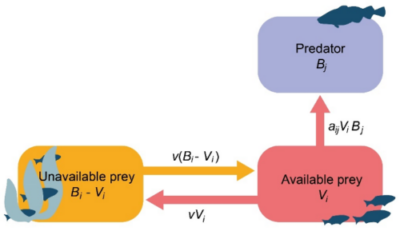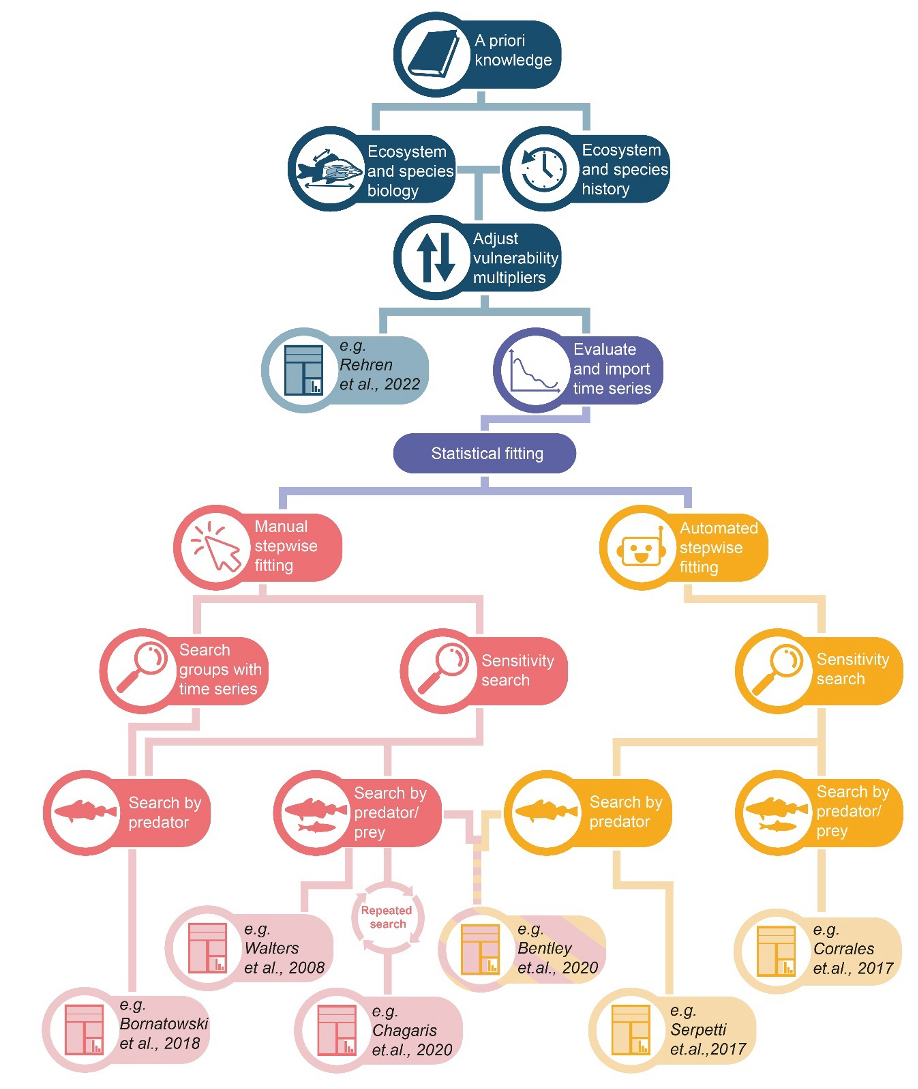31 Vulnerability and vulnerability multipliers
Jacob Bentley; David Chagaris; Marta Coll; Sheila JJ Heymans; Natalia Serpetti; Carl J. Walters; and Villy Christensen
Ecosim predictions are sensitive to the Ecopath input parameters (usually biomass, production and consumption rates, diet, and fishery removals) as well as the predator-prey “vulnerability multipliers”, which are conditioned on the Ecopath inputs and tuned during model calibration. In Ecosim, vulnerability multipliers have implications for stock-recruit dynamics, density dependence and compensation, carrying capacity, stock resiliency, interspecific interactions, and ecosystem energy flow[1]. However, the effect of different calibration strategies on the estimation of vulnerability multipliers in Ecosim and emergent stock productivity estimates has not yet been demonstrated, nor do we understand in a comprehensive way how sensitive model outputs are to different approaches and how this may influence derived advice.
Ecosim predictions of consumption based on a simple mass-action model have been modified to consider the non-random dynamics of the foraging arena[2] [3] [4]. Prey biomass pools in Ecosim are dynamically divided into vulnerable and invulnerable components, which imply behavioural or physical mechanisms that limit the rate at which prey become vulnerable to predation (Figure 1[5]). The transfer rates between these components determine the amount of prey available to a predator and thus the degree to which a change in predator biomass will impact predation mortality and prey biomass.

Figure 1. Simulation of flow between available (Vi) and unavailable (Bi−Vi) prey biomass in Ecosim. aij is the search rate of prey i by predator j, v is the exchange rate between the vulnerable and un-vulnerable state. Fast equilibrium between the two prey states implies Vi=vBi/(2v+aBj). Based on Walters et al. (1997).
When working with Ecosim, one cannot adjust vulnerability exchange rates (vij) directly. Instead, this is done via vulnerability multipliers (kij), which can be more easily interpreted as the maximum increase in predation mortality rate that a predator can exert on a prey if the predator were to grow to its carrying capacity. The increase is relative to baseline Ecopath predation mortality rates (M2, where M2=Qij/Bi) The vulnerability exchange rates (vij) are then set to the vulnerability multiplier (kij) multiplied by the baseline predation mortality (M2), i.e. vij=kijM2. Multipliers can range from one to infinity with two as the default value.
The vulnerability multipliers are derived from the Ecopath baseline, and do not automatically change when running Ecosim across years. Ecosim dynamically handles the consequences of changes in predator and prey abundance based on the baseline situation, including changes in carrying capacity over time. The default value for kij of 2.0 assumes that the predation mortality rate can double at most, while a value down near 1.0 means that the predator is at its “carrying capacity”, which by definition means it fully utilizes its prey, so it cannot further increase the predation mortality it’s causing on the prey.
High vulnerability multipliers imply top-down control, and low bottom-up control. Top-down control occurs where a predator is far from its carrying capacity, here, e.g., a doubling of predator abundance may result in close to a doubling in the predation mortality it are causing on it prey. With low vulnerability multipliers where a predator is at its carrying capacity, any increase in consumption has to be linked to changes in prey productivity – i.e. to bottom-up factors.
For exploited species, it is thus extremely important to recognize that vulnerability multipliers do not only reflect the ecological limits caused by prey and predator behaviour, but also how depleted the exploited species is in the base Ecopath biomass state relative to the natural level (i.e., carrying capacity) that might be achieved if fishing were stopped. As such, for overexploited species to recover following reduced fishing, vulnerability multipliers need to be set relatively high so that predators can consume far more prey than in the initial Ecopath snapshot. Higher vulnerability multipliers tend to make groups more sensitive and responsive to changes in fishing mortality.
Over time, multiple approaches to parameterize the vulnerability multipliers have been developed and adopted (Figure 2). While some approaches derive estimates from a priori knowledge and ecological observations or hypotheses in data-poor situations[6], users are more frequently turning to formal statistical estimation using calibration time series and a tuning process when time series are available[7]. Statistical fitting routines estimate vulnerability multipliers that bring simulations closer in-line with observations. However, users should be cautious, as statistically optimized multipliers may stray away from values that might be considered ecologically realistic. A thorough sense check is always recommended. The following sections explore these different approaches in more detail.

Media Attributions
- From Bentley et al. 2024 Figure 1
- From Bentley et al. 2024. Figure 2
- Walters, C.J., Martell, S.J. 2004. Fisheries ecology and management, Vol., Princeton University Press, Princeton, New Jersey ↵
- Walters, C., Christensen, V., Pauly, D. 1997. Structuring dynamic models of exploited ecosystems from trophic mass-balance assessments. Reviews in Fish Biology and Fisheries 7: 139-172. https://doi.org/10.1023/A:1018479526149 ↵
- Walters, C., Pauly, D., Christensen, V. and Kitchell, J.F., 2000. Representing density dependent consequences of life history strategies in aquatic ecosystems: EcoSim II. Ecosystems, 3(1): 70-83. https://doi.org/10.1007/s100210000011 ↵
- Ahrens, R.N.M., Walters, C.J. and Christensen, V. (2012), Foraging arena theory. Fish and Fisheries, 13: 41-59. https://doi.org/10.1111/j.1467-2979.2011.00432.x ↵
- Walters et al., 1997. op. cit. ↵
- e.g., Rehren, J., Coll, M., Jiddawi, N., Kluger, L.C., Omar, O., Christensen, V., Pennino, M.G. and Wolff, M., 2022. Evaluating ecosystem impacts of gear regulations in a data-limited fishery—comparing approaches to estimate predator–prey interactions in Ecopath with Ecosim. ICES Journal of Marine Science 79(5):1624-1636. https://doi.org/10.1093/icesjms/fsac077 ↵
- e.g., Scott, E., Serpetti, N., Steenbeek, J. and Heymans, J.J., 2016. A Stepwise Fitting Procedure for automated fitting of Ecopath with Ecosim models. SoftwareX, 5, pp.25-30. https://doi.org/10.1016/j.softx.2016.02.002 ↵

